Many of you asked:

Typically, I give an ambiguous response, not because I want to be snarky, but because beauty is in the eye of the beholder. Today, however, we will discuss the statistics of the metadata for the Season 1 Artie NFT collection. We are putting this information out for two reasons: 1) so our community is better equipped to understand our NFTs, and 2) to show you the beauty that lies in your NFT, just buried a few layers down in the warm JSON code.
As we peel away the layers of our NFTs, let’s use a real Artie NFT to demonstrate everything we are talking about. Let’s pull up Bosspaw from the Sock Exchange Thrift Store, who is Token ID # 1374. In the spirit of transparency, this is an NFT that my dad minted!
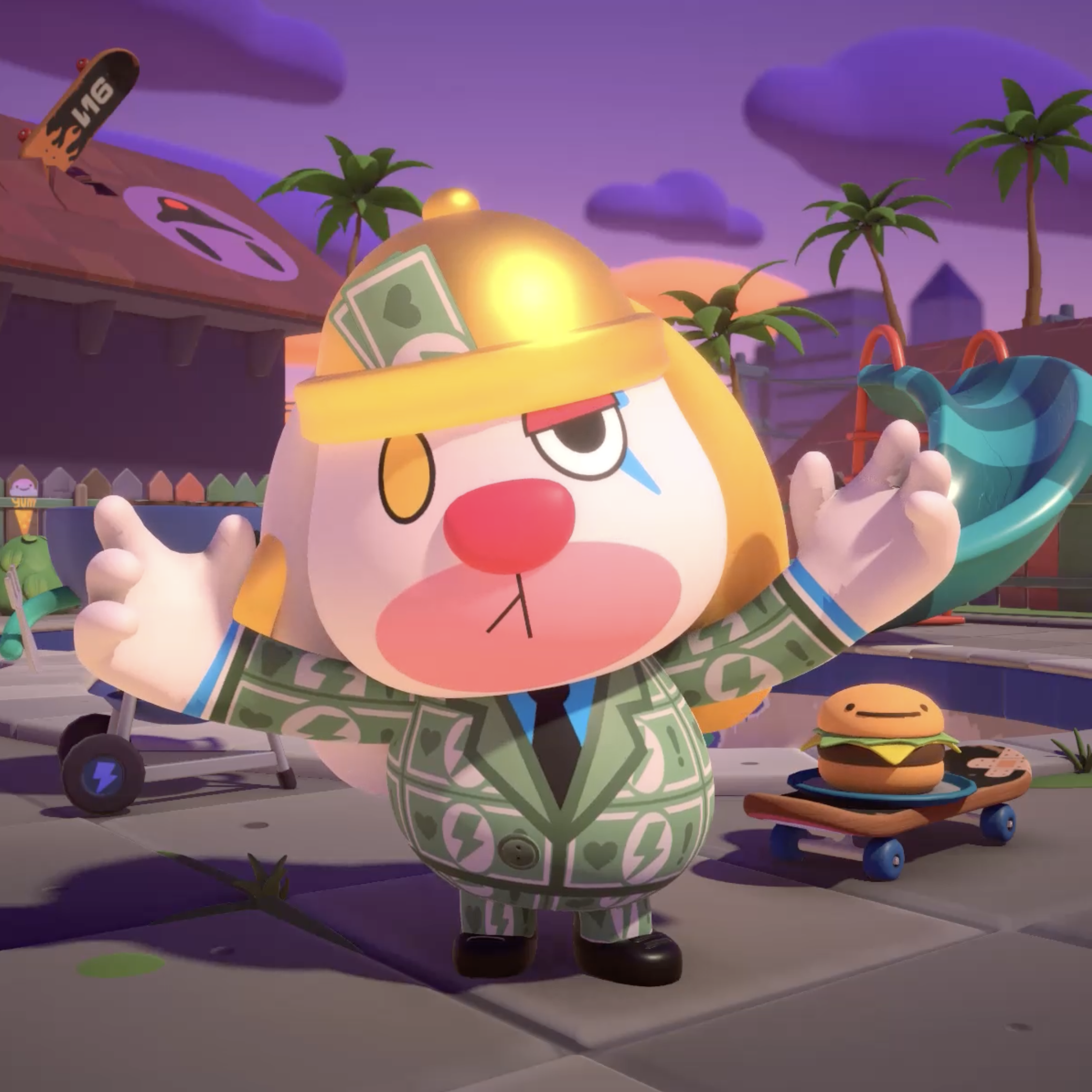
Layer 0: the Metadata
You can find the raw metadata for any Artie NFT at:
https://metadata.artie.com/artie/XXXX
Please replace the XXXX with your token ID. You will soon be greeted with a fat wave of JSON like this:
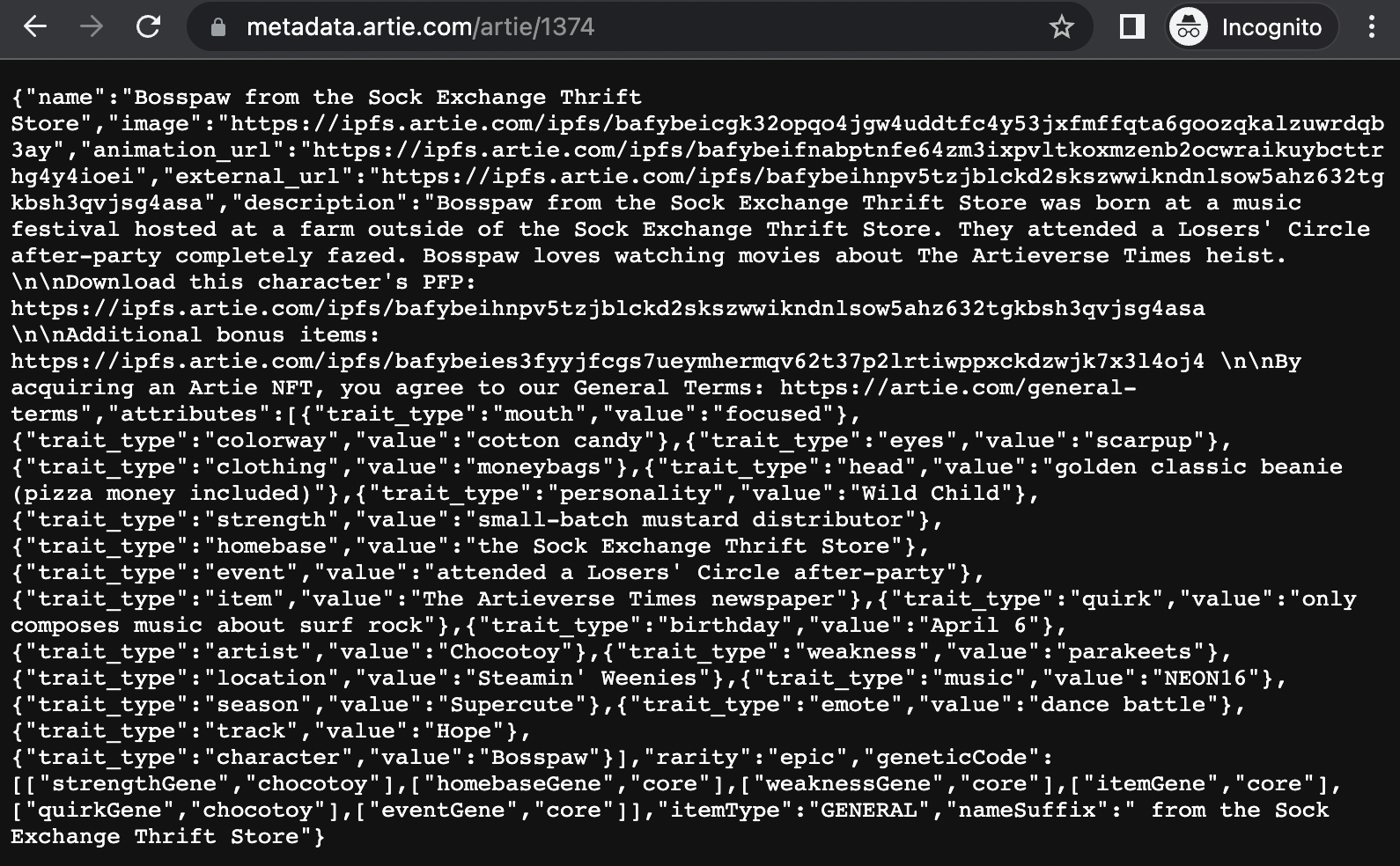
If that’s gibberish to you, copy the code, and paste it into a JSON parser:
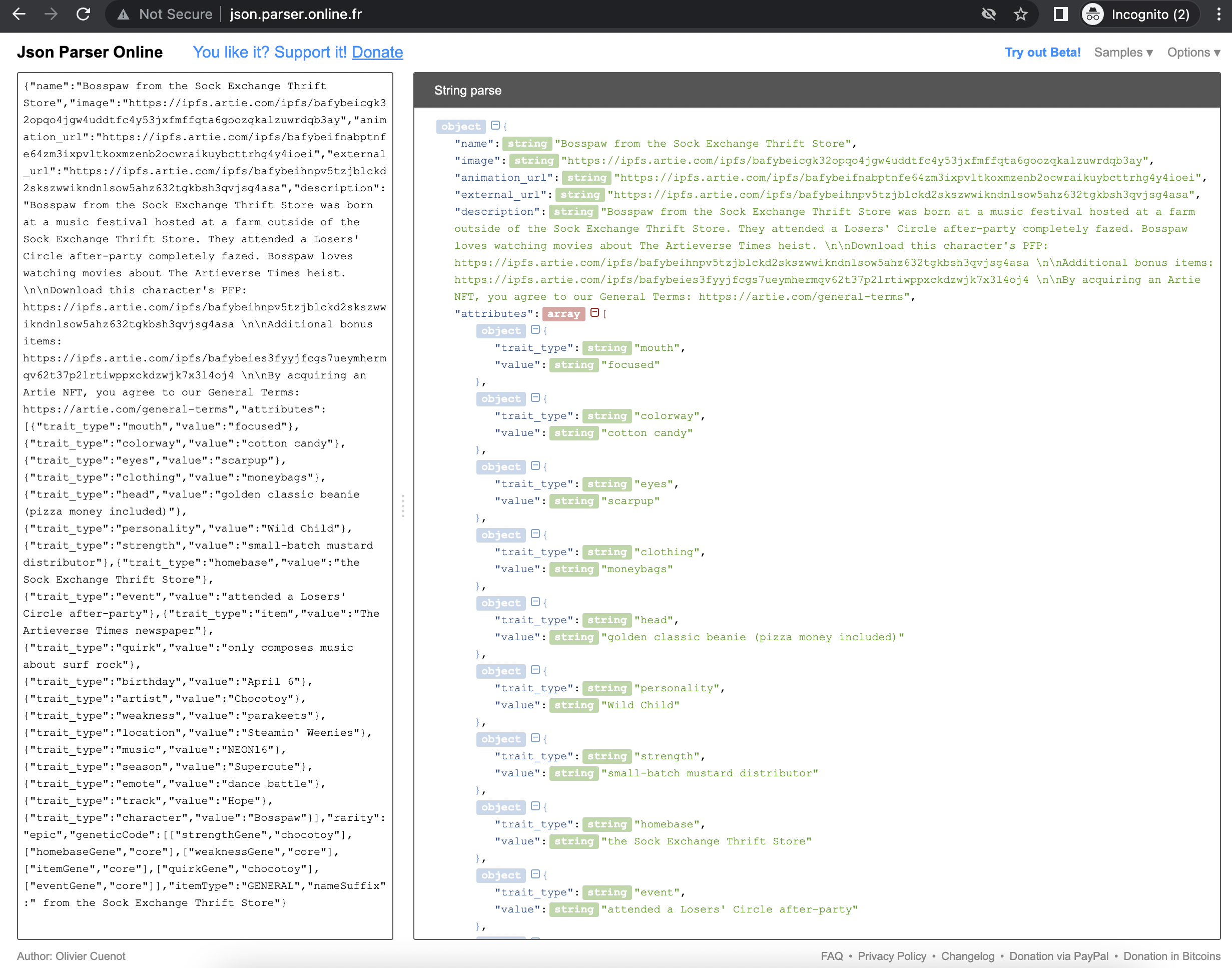
I’ll occasionally refer to the metadata, especially when we get to the genetics layer.
Layer 1: the Attributes
The attributes metadata already appears on Opensea, and most other marketplaces. However, there is more metadata outside of the attributes section. In the JSON parser the attributes are everything that is in the “attributes” section:

On Opensea the attributes appear in the “Properties” section:
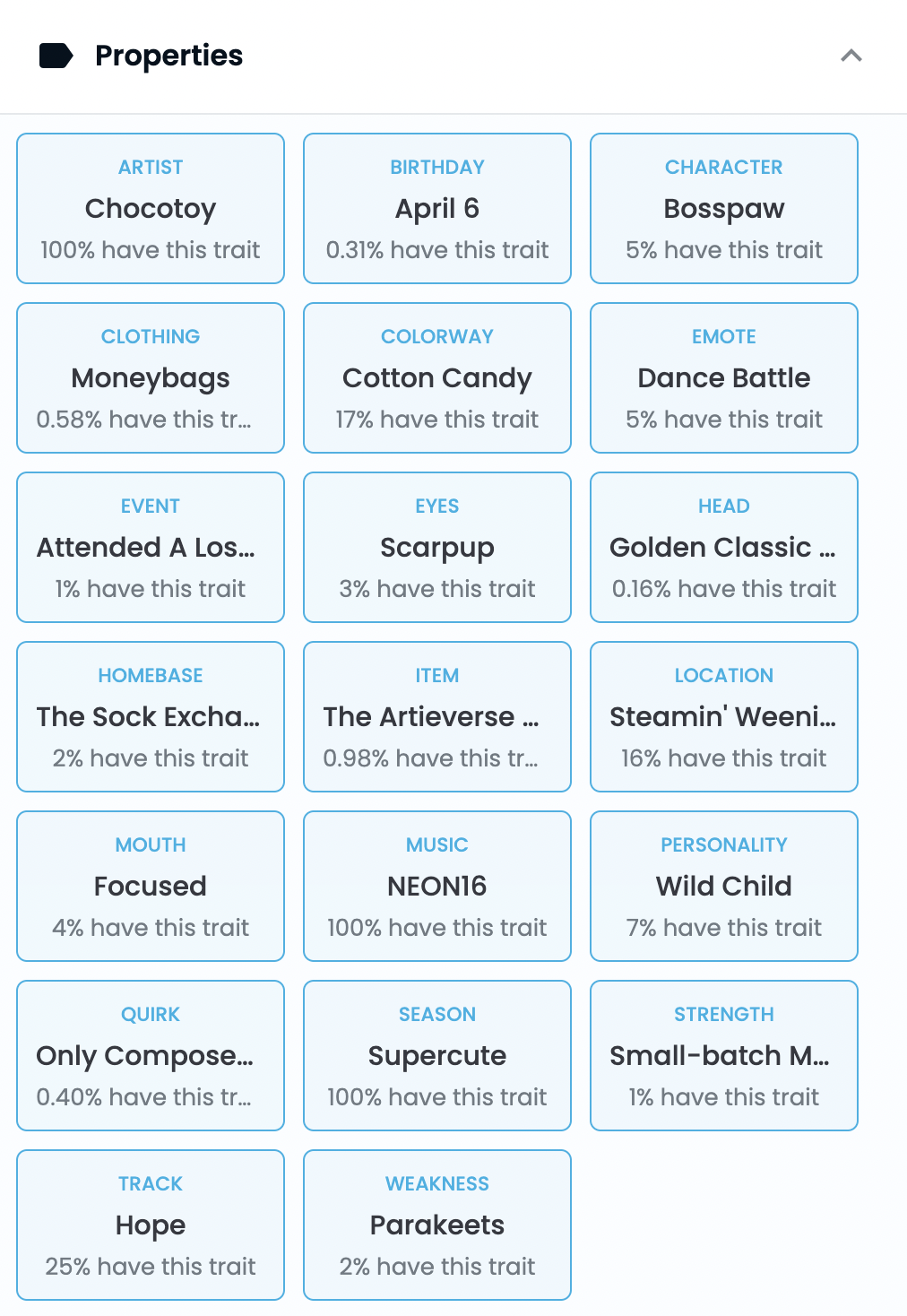
Neither of these displays are ideal for displaying our metadata. This character has 20 traits, and some of our characters have even more. That is why our roadmap includes “Lore Viewer & Artie Profiles.” We’re currently designing a site that can display the complexity and deep detail of your Artie NFTs.

What about rankings?
At Artie, we do not endorse any ranking platforms. Most of these platforms only rank NFTs by the attributes listed above, which is the metadata shown in the Opensea Properties region. This is a flawed metric to compare NFTs; it has no awareness of the other layers of the NFTs. We will discuss those layers in the remainder of this post, but first we will define the metric most ranking platforms use to calculate rarity. The process for calculating rankings on an NFT collection typically boils down to the following:
Let N be the set of all NFTs in a collection. This is hypothetical, so let’s also assume the size of the collection is 10,000, hence |N| = 10,000. Let ni be an NFT with token ID i from collection N. Mathematically speaking we can say:
∀ i where 1 ≤ i ≤ 10000, n_i ∈ N.
Let’s define a function A that maps an element in the collection (any n_i), to an ordered list of occurrences for each attribute. Let’s call this an an attribute occurrence list, AOL. Let’s specify the AOL of n_i is AOL_i.
Let’s assume this hypothetical collection has 20 attributes across all NFTs, as most NFTs in Artie’s collection have 20 attributes. The structure of the Attribute Occurrence Lists is as follows:
A(ni) → AOLi
AOL_i = < o_i,1, o_i,2, o_i,3 … o_i,20 >
|AOLi| = 20
Each of these values is an integer greater than 0. The occurrence represents the amount of times the current attribute appears in the collection.
For example, “The Artieverse Times” item only appears in the collection 44 times so far, and items is the 11th attribute alphabetically, and let’s say this item is present on the NFT with token ID 1374, so we can say:
o_1374,11 = 44
Now we have the structures to calculate rankings!
For each character in collection N, add up the occurrences of each attribute in their attribute occurrence list. To represent this summation, we will use the following syntax:
Σ(AOL_i) = o_i,1 + o_i,2 + o_i,3 + … + o_i,20 = σ_i
Then sort the summed occurrences in ascending order. The characters that appear in the front of the list have the highest rankings according to this arbitrary metric. Mathematically speaking:
∀ i where n_i ∈ N, calculate A(n_i) → AOL_i
∀ i where n_i ∈ N, calculate Σ(AOL_i) = σ_i
Sort the set of all σ_i in ascending order, and put in in an ordered list called R. R(i) returns the NFT with the i-th least occurrent attributes. So R(1) represents the rarest NFT by this AOL-based metric.
Most ranking systems I have seen use some version of this. Some might weight specific attributes more heavily, but that can be achieved just by adding a weighting scale factor to this formula:
Σ_weighted(AOL_i) = w_1*o_i,1 + w_2*o_i,2 + w_3*o_i,3
+ … + w_4*o_i,20 = σ_i
This technique is just one way to measure the rarity of NFTs, assuming your rarity metric is: the NFT with the least occurrent set of attributes is the rarest NFT. However, there is no best metric to evaluate NFTs. Everything can’t be quantified. Vibes and personal taste are important. Our NFTs have other features that aren’t measured in attribute occurrence based calculations. Another caveat is rarity doesn’t directly correlate with value.
There is a disconnect between attribute occurrence based rarity metrics and reality. This gap is a huge canyon if you look at the statistics of the birthday traits. There are 366 possible birthdays. The birthdays occur between 5 and 23 times across the collection so far. Currently, October 10th appears only 5 times in the collection.
Does that mean that it is a rare property and has value? Maybe?
A counterpoint to occurrence based rarity, specifically for birthdays, is significant days: like 4/20, also known as April 20th, which occurs 16 times in the collection. It’s three times more common than the rarest of birthdays, but it’s a date that has significance to large swaths of our community. So, I would argue that significant dates are more important than statistically rare dates. However, rarity platforms do not account for this.
Layer 2: Genetics
Take a look at the genetics for the Bosspaw from earlier:
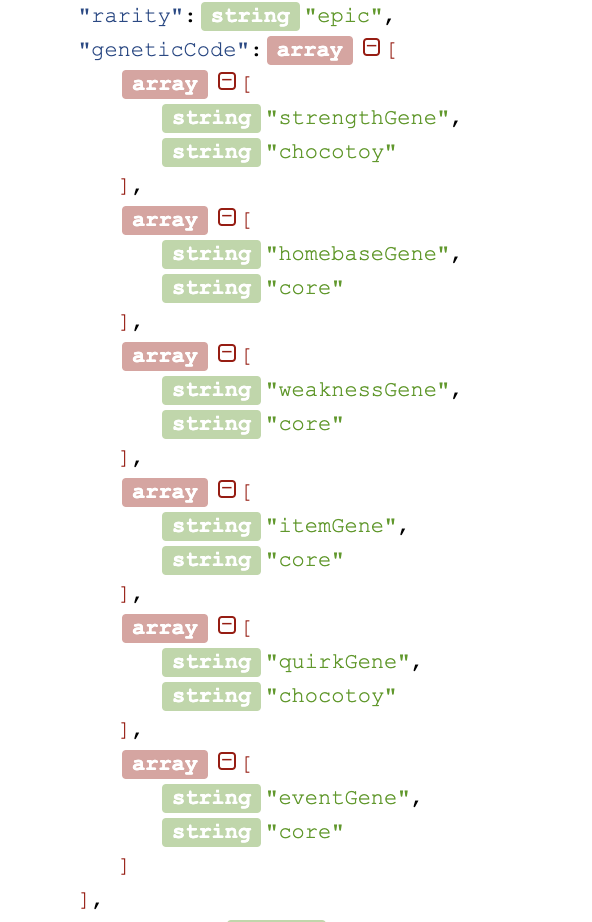
Each NFT has 6 genes, one for each of the narrative traits. This particular character has four core Artieverse genes, and two Chocotoy genes. Colloquially, I like to call this a 4/6 or a 66.666% core gene affinity. Currently the only gene types are core and chocotoy. Season two will also have two genes: the core Artieverse gene, and a new secret gene which represents the essence of the season’s theme.
What does this mean?
- Each narrative trait comes from a pool of either core Artieverse traits or a pool of Chocotoy traits.
- If the trait comes from the core Artieverse gene pool, then its corresponding gene is
core. - If the trait comes from the Chocotoy gene pool, then its corresponding gene is
chocotoy.
- If the trait comes from the core Artieverse gene pool, then its corresponding gene is
Is it better to have 100% genetic affinity?
It depends. Maybe you’re a big fan of Chocotoy’s SuperCute vibes, and want a character whose narrative traits all come from the Chocotoy Neighborhood. In that case, it makes total sense to want a character with 100% Chocotoy genetic affinity.
In the full first season 5,004 characters, there are only 71 characters with 100% Chocotoy genetic affinity, and 107 characters with 100% core Artieverse genetic affinity. Here is a chart that shows the distribution of the characters with respect to the percentage of their Chocotoy genetic affinity.
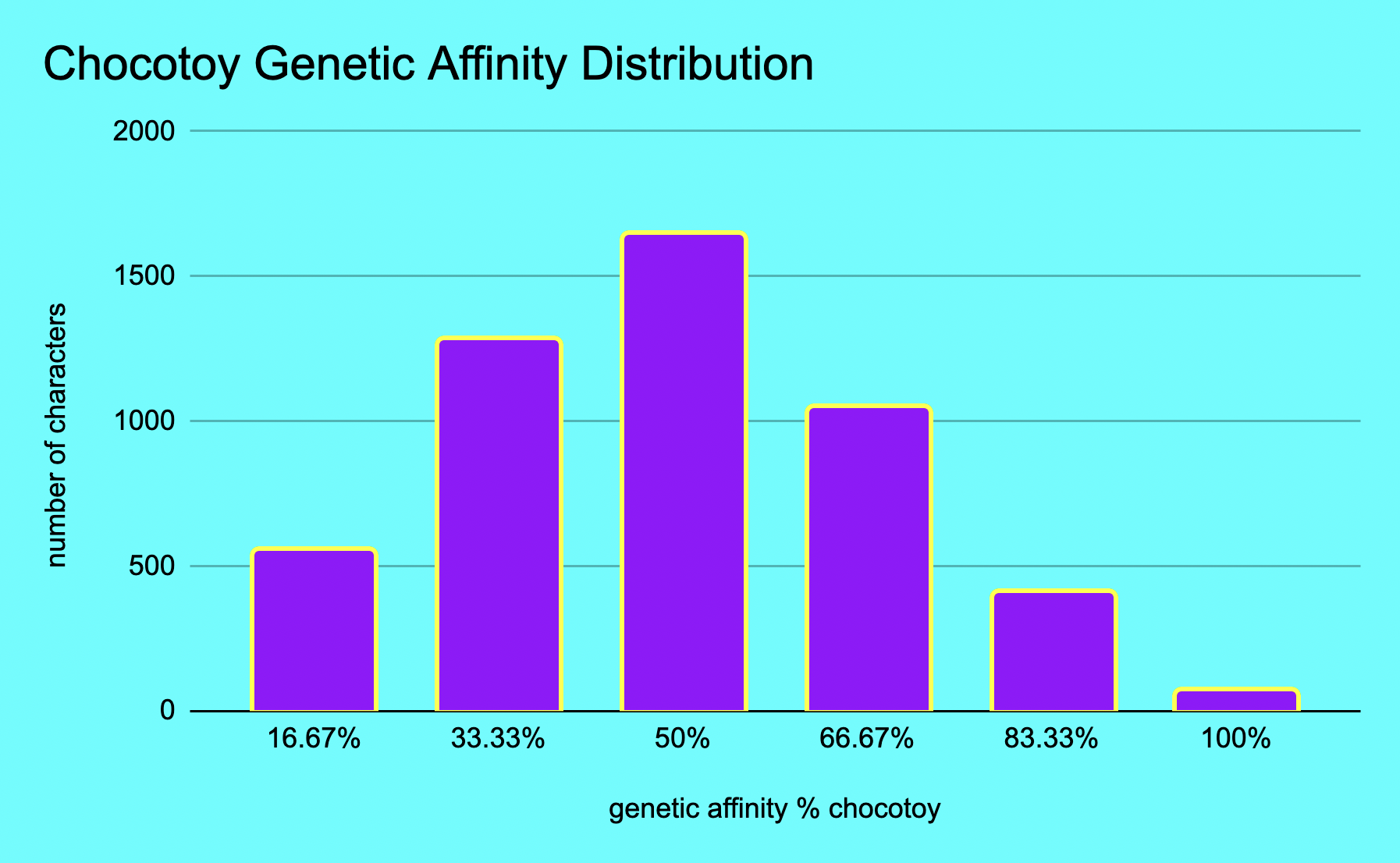
Our genes were inspired by the affinity system from Forgotten Runes Wizards Cult. We like the wizards.
Layer 3: Names
Let’s pull up an interesting Artie character. Their name is Flex:
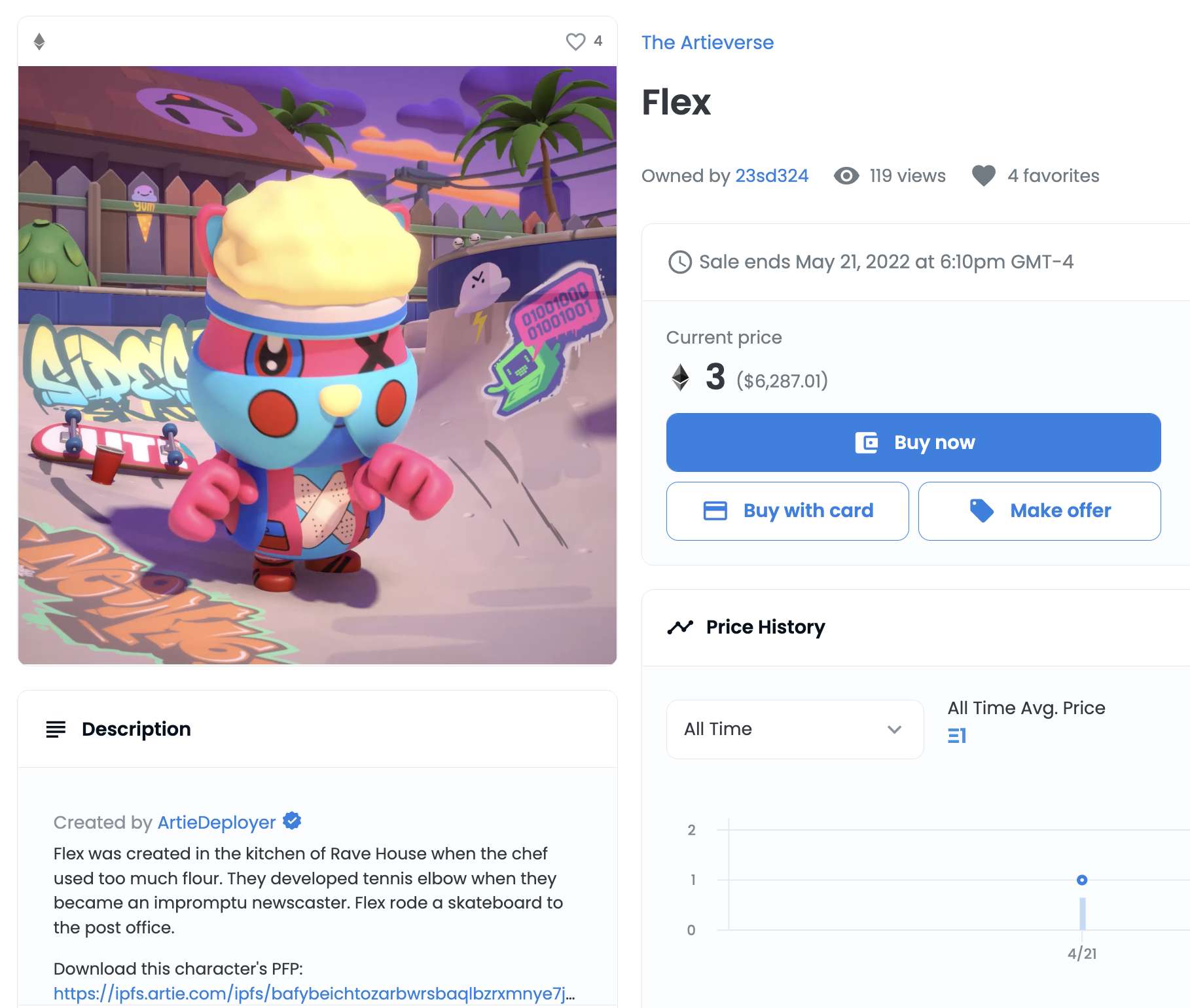
What is special about this character? I think they’re cool because their name is simple and clean; it’s just one word, Flex. In our collection there are currently 1349 characters with Flex in their name, around 30% of the collection. However, this is the only Flex with the name Flex. That is super cool to me.
Each of our character types (Flex, Wrocky, Bosspaw, Unicorn, The Drip, and Dreamdust), have a character whose name is just the name of the character model. Additionally, there are some names like Flex the Loner. These names include the personality type of the character. There are only 15 Flex characters that only have the name and the personality type, with no other modifiers.
Additionally, there are characters with exceptionally long names in our collection. Only two of our characters have the phrase who is a in their full name. These are Flex the Zero-Gravity Pilates Instructor who is a Monster from Dex's Donuts and Flex the Gourmet Toaster Chef who is a Jerk from Shady's Sunglasses Emporium. It’s just a coincidence that all the characters we are bringing up in this section are Flexes. However it goes to show you, even if you have a character that occurs often throughout the collection, there is always something unique waiting for you in the metadata.
I am bringing this to your attention so you can start to keep tabs on our naming conventions. We were super intentional in designing our naming system, and we want you to be aware of the features we put into our collection.
BTW, there will be new naming syntaxes in season two….
Layer 4: Lore
Some characters have unique lore. Check out the first sentence in the lore on Flex the Stepdad for Hire from Decentral Station, who is token ID #666:
Flex the Stepdad for Hire from Decentral Station was summoned when a demonic scientist combined every flavor of BTD.
This Flex is the only character in the first season who was summoned by a demonic scientist. There are tons of other characters with customized lore. There are tons of characters with special lore! Find them. Rarity trackers aren’t equipped with the natural language processing (NLP) to find characters with unique lore. This is something we want you to explore manually.
Another layer: the lore for your characters will grow as you use them. You control your character’s destiny. Make your character legendary through your own efforts!
NFT Aesthetics
I want to wrap up this post with a musing on NFT aesthetics. Let’s circle back to Bosspaw from the Sock Exchange Thrift Store.
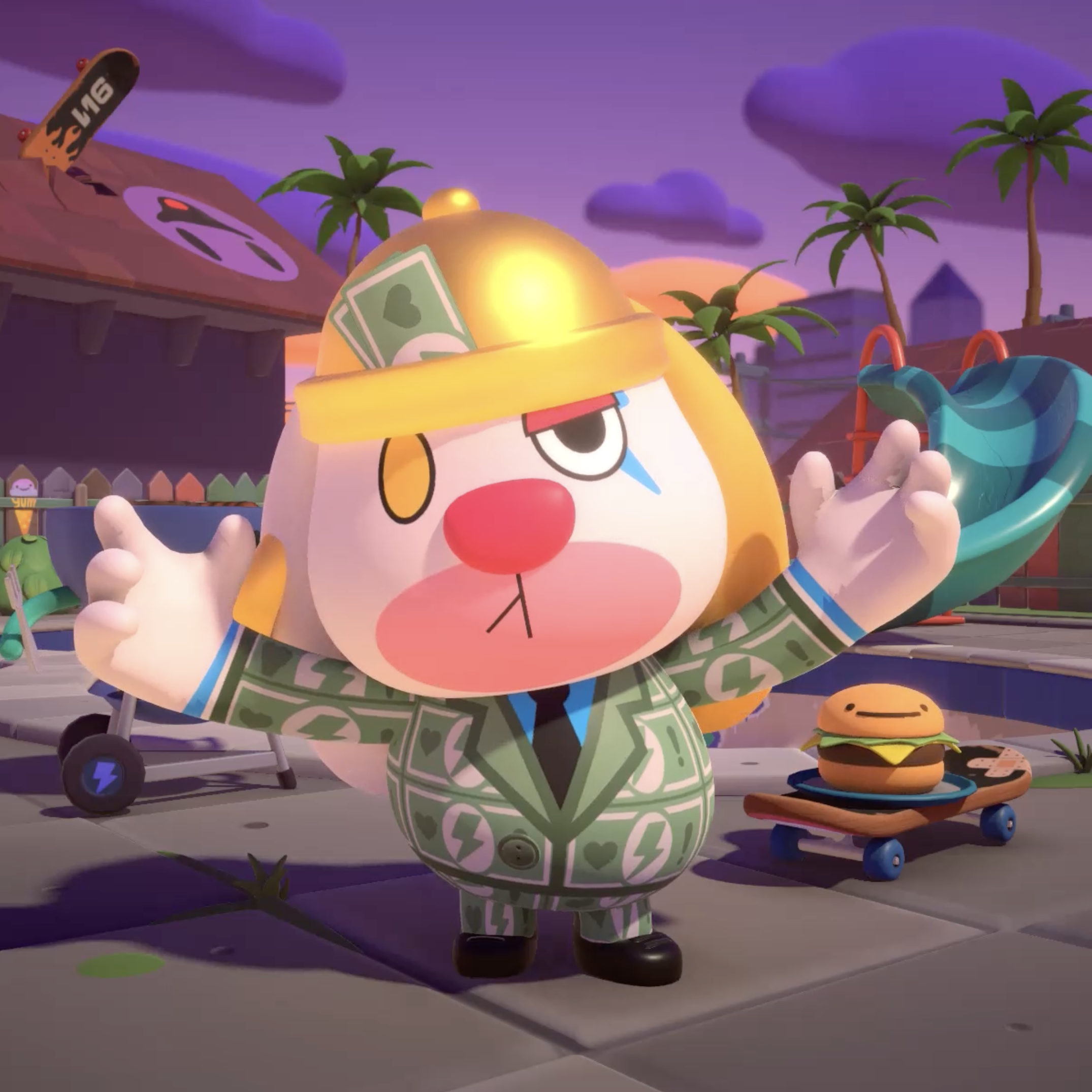
Look at their hat. Look at their suit. See anything special? There is pizza money in their hat, and they’re wearing the Moneybags suit. This is an aesthetically pleasing combo. If we do a bit of querying we can see that this is the only Bosspaw that has a golden hat with pizza money, and a Moneybags suit. So far there are only four Bosspaws with money in their hat and a money suit.
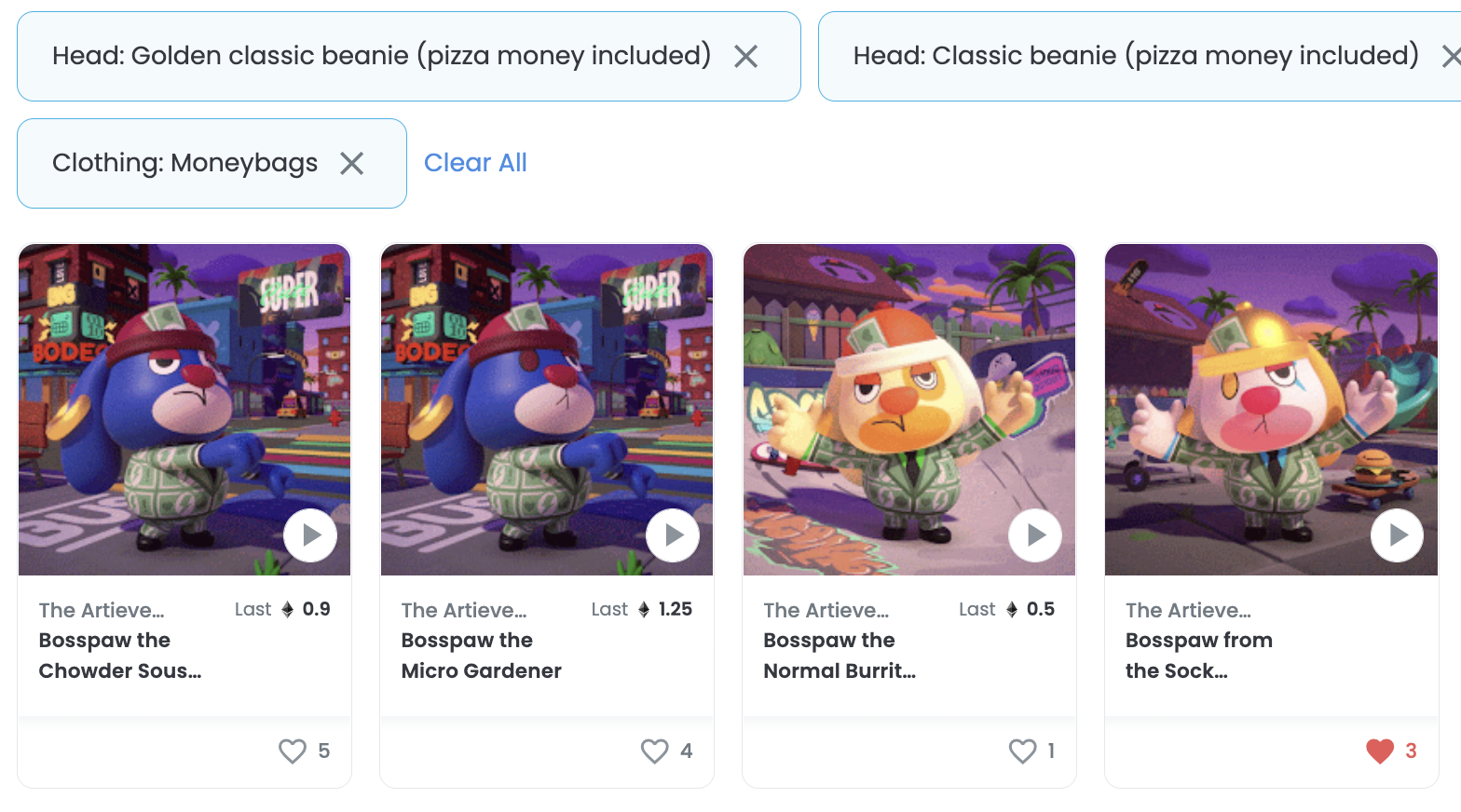
I’m bringing up this one connection to inspire the community to look for more of these aesthetically pleasing connections. There are more hidden in our collection. We want you to find them. These connections aren’t explicitly encoded in the metadata. This makes it impossible for a rarity tracker platform to automatically understand the rarity in our collection because. At least until, we teach the AI about contemporary aesthetics.
We have many layers of complexity, and most of them can’t be understood by just counting metadata traits. This is not the end of this discussion. We hope this post inspires you to go down the rabbit hole…